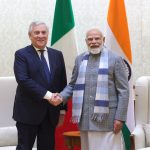It’s the season of China-bashing in India. In bad old socialist days, the ruling party in India was quick to conjure up the “foreign hand” to distract public attention from a host of domestic crises. Now, it’s the turn of market-driven media to manufacture “external threats” to spike their TRP ratings.
But blaming the “testosterone-driven” media for sexing up the spectre of China threat, as top officials and the army chief have done, is only part of the story. It’s easy to scoff at “conspiracy theorists,” but paranoia is sometimes an act of good citizenship. Instead of discrediting the media, it’s important to understand why the China threat story sells in the overheated media marketplace in India.
First, recent incursions, dismissed by India’s external affairs ministry as routine incidents that occur due to differences in perception about the Line of Actual Control (LAC), are by themsleves not alarming. But they have gained credence due to a string of much-reported hostile posturing by Beijing against Indian interests over the last year.
It started with China trying to block India’s quest for global nuclear trade in the Nuclear Suppliers Group (NSG) in September last year despite a pledge at the highest level that Beijing won’t stand in the way of India’s journey to nuclear liberation. In the end, China did not stand in the way of the deal it perceived as Washington’s strategy to contain its rise. However, its calculated vacillation had exposed chinks in the 2.0 version of Hindi-Chini bhai bhai. It also unveiled China’s anxieties about India emerging as a rival power in the Asian hemisphere with US support.
India, however, chose to put China’s negative NSG role behind in the interests of keeping relations on an even keel, but the message was not lost on India’s opinion-making class and news-consuming middle class.
A few months later, China again tried to play the spoiler by trying to block India’s $2.9 billion development loan proposal at the Manila-headquartered Asian Development Bank. China put its foot down on the grounds that a part of the package included $60 million for Arunachal Pradesh over which Beijing claims sovereignty. The move was seen by many in India as a devious manoeuvre by Beijing to internationalise Arunachal Pradesh in multilateral forums where its clout is steadily growing.
China’s double standards came to the fore when it signed an MoU with its client state Pakistan in August 2009 to construct 7,000 MW Bunji dam in Northern Areas of Pakistan-controlled Kashmir, which is claimed by India in its entirety.
Amid all these negative signals, the two emerging Asian powers have kept their diplomatic engagement on course by downplaying irritants and broadcasting aloud the latest bilateral trade figure, which is said to have surpassed $50 billion. The leaders of both countries never tire of ruling out rivalry and repeating the ritualistic talk of enough space for both India and China to grow, but such platitudes have not entirely obliterated the trust deficit that dates back to the bruising 1962 war.
More recently, an article attributed to a Chinese strategist – subsequently disowned by the powerful Chinese strategic establishment – exhorted China to balkanize ‘Hindu India’ into 20-30 independent states, eliciting a sharp reaction from India’s external affairs ministry. Coupled with these discordant notes is the growing unease India is feeling with Beijing’s calibrated string of pearls strategy of extending its influence among India’s neighbours like Nepal, Bangladesh, Sri Lanka and Myanmar.
The resonance of the China threat has another deeper source in the collective Indian middle class psyche that has nothing to do with Beijing’s perceived hostility. It is the appeal and power of the China Rising story. China, with its double digit rate of economic growth over last three decades except for this recession-ridden year, has outstripped India in virtually every sphere, be it infrastructure development, poverty eradication, energy security, Olympic golds or cutting-edge areas of science and innovation.
More Indians are travelling abroad now and are familiar with the shining, world-class cities Beijing and Shanghai have morphed into and they can’t find a parallel nearer home. One has only to compare the ruthless efficiency and panache with which Beijing hosted the 2008 Olympics with the kind of panic that has gripped India months before the Commonwealth Games 2010 to understand why the China threat stirs the great Indian middle class.
But the threat, as the Chinese character for that word suggests, also represents an opportunity. Instead of being intimidated, India should seize the hour and seize the day (in Chairman Mao’s famous words) to revive and sustain its economic growth, bolster its woefully inadequate infrastructure and transform this country with over five hundred million poor into a developed country in the next decade or so.
The deadline for China threat is 2020, the defining year Beijing has set to mark its entry into the developed world. If India’s rulers are still posturing by that time and not addressing all too real issues of development and equity, then the threat has a potential to turn real, albeit not necessarily in the sense of a military confrontation.
Author Profile

- Manish Chand is Founder and Editor-in-Chief of India Writes Network (www.indiawrites.org) and India and World, a pioneering magazine focused on international affairs. He is CEO, Centre for Global India Insights, an India-based think tank focused on global affairs.
Latest entries
 India and the WorldDecember 12, 2025India-Italy bonding: Tajani’s visit raises the bar for business, maritime ties
India and the WorldDecember 12, 2025India-Italy bonding: Tajani’s visit raises the bar for business, maritime ties In ConversationNovember 26, 2025G20 is a Force for global Good
In ConversationNovember 26, 2025G20 is a Force for global Good articlesNovember 26, 2025Rescuing G20 from North-South divide: Ubuntu Moment
articlesNovember 26, 2025Rescuing G20 from North-South divide: Ubuntu Moment India and the WorldOctober 27, 2025Modi hails the century of India and ASEAN, backs ASEAN centrality
India and the WorldOctober 27, 2025Modi hails the century of India and ASEAN, backs ASEAN centrality







